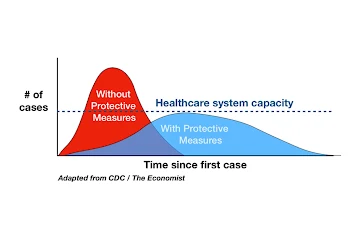In the wake of novel coronavirus taking over the entire mankind, you can't go one second without hearing the news channels talk about it and you certainly cannot go one scroll without stumbling upon a piece of information that isn't about the pandemic. Bu half-baked knowledge is a risky business especially when every human, every inch of this planet is talking about the same subject across all the communication platforms there is.
While I respect every slice of knowledge, data, facts, videos and the news updates being shared on social media, what worries me are the ones that have flurry, wrong, undercooked words that can easily be miscommunicated and turned into the pile of lies or myths.
In the light of releasing the correct message on a personal level let's take a small step of fact-fully getting our COVID-19 related words like social distancing, novel coronavirus, self-quarantine, etc. right and sanitize others who are using it wrong, politely!
1. Coronavirus
Making it clear as crystal, coronavirus is not the diseases, it is basically an umbrella term for a family of the virus which already exists in the world. Previously found in animals, the traces in humans is a new area for medical experts as well.
2. COVID-19
The very term evoking unmitigated horrors in the entire world, COVID-19 is a new type of coronavirus technically known as SARS-CoV-2. The whereabouts of its origin are currently unknown thus making it difficult for the scientists to create a counter vaccine or medicine.
3. Novel
Literally means new, in the case when used with coronavirus or nCoV, it simply denotes that this is a new strain of the virus that was previously unidentified in the human body.
4. Self-Isolation
Isolation is itself a medical term which means the separation of a patient, suffering from a contagious disease, from contact with others. When associated with COVID-19 pandemic, it refers to the serious need of keeping away the confirmed infected individual away from the uninfected ones in a safe environment. A strict no physical interaction has to be followed to slow down the spread of this virus.
5. Self-Quarantine
Often used as a replacement of self-isolation, self-quarantine has a different dynamic of separation altogether. If a person is under self-quarantine, firstly it implies that this person is at a higher risk of being infected from the virus than the others but it still isn't confirmed. Now this will depend on their medical history, age and travel history. In any case, the person is suggested to isolate themselves in their homes only. Although they need to stringently stay at home all the time with no visitors knocking at their door whatsoever, maintain a 6 feet distance from other family members and avoid sharing towel, utensils and other hygiene products with others.
6. Social Distancing
Social distancing hints at deliberately increasing the space between people to avoid the spread of coronavirus. Also called physical distancing, this act calls for maintaining a safe distance of 3 feet to 6 feet at all times from any other individual. Working from home, schools being closed, prohibiting meetings and gatherings are all part of practising safe social distancing. This is the least you guys can do while sitting at home.
7. Self-Observation
Sticking to your alert side by keeping a thorough check for COVID-19 symptoms like fever, dry cough, fatigue or difficulty in breathing and seeking medical help on time is the basic crux of self-observation. For any mild symptoms, you are highly recommended to get in touch with your doctor to monitor the situation over a call rather than hurrying to a clinic every now and then. Educate your loved ones to do the same!
8. Community Spread
The third stage of an epidemic, when the infection source spreading the disease is now unknown. In other words, a geographic area in which there is no knowledge of how someone contracted the disease and the medical experts are unable to track the index patient (source carrier infecting everyone). The only way to find out who has the virus is when their symptoms begin to show up after a 14 day incubation period. That's when you rush to the doctor.
9. Incubation Period
The time period required by the virus to develop symptoms in the body is called the incubation period. Further explaining, the time-gap between the contraction of the virus by our body and clear visibility of symptoms is incubation period. For coronavirus, the incubation period is 3 to 14 days.
10. Flattening The Curve
An attempt to gradually slowing down the rate at which the disease is spreading is what we call Flattening the curve. By flattening the curve of the COVID-19 spread, we reduce the number of patients who are ill from the disease at any one time so that we do not overwhelm the health care system. And this can only be achieved when everyone follows said precautions with honesty.
For your reference:

Image Courtesy: The New York Times
When it comes to COVID-19, a pandemic taking over the whole world, getting your terminology right is the only way to communicate effectively. And in all it's bleak, one thing that is giving me constant hope is the fact that all of us are in this together and this too shall pass!

